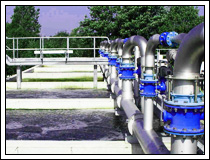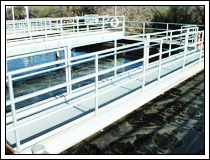Tertiary Treatment
What is Tertiary Sewage Treatment?
After biochemical degradation of the sewage in the secondary treatment, the clarified effluent is further treated to treat it of the non-biodegradable toxic organic pollutants such as chlorophenols, polychlorinated biphenyls and other synthetic pollutants. This entire process is known as Tertiary treatment. For this purposes activated carbon filters are used.

Removal of heavy metals like mercury, lead, chromium and cadmium are also done during tertiary treatment. These metal ions, which are found absorbed in the sewage water are converted into either toxic products or residues. These residues remain associated with the micro biopolymer matrix and are either released during sludge treatment or are remobilized after sludge disposal.
Tertiary treatment is the last step of the entire sewage water treatment process, after this the waste water becomes comparatively safer and can be discharged into the environment. There are several types of tertiary treatment, all of which brings some kind of improvement in the quality of the waste water so that its impact on the environment into gets reduced.
Different Steps of Tertiary Sewage Treatment
Tertiary Treatment of sewage water includes processes like filtration, lagooning, nutrient removal, and disinfection, which are discussed below:
Filtration
In the filtration process, either sand, charcoal or activated carbon are used to filter the wastewater. The water is made to pass through a bed of sand or charcoal, so that the particulate matter in the water adheres to the filter medium and gets removed from the water.
Lagooning
In lagooning, water is stored for some time in artificial lagoons or ponds with plants and invertebrate animals to ingest the biodegradable particles in the sewage water. The water is stored in these ponds for sometime time so that these plants and invertebrate animals improve the quality of water by ingesting the remaining particulate matter.

Nutrient removal
Removal of nutrients nitrogen and phosphorus is necessary as their excessive release to the environment can lead to eutrophication that in a way lead to the overgrowth of weeds, algae, and cyanobacteria (blue-green algae). This lead to a phenomena called Algae Bloom, where there is a rapid growth in the population of unsustainable algae which eventually dies. As the bacteria works on the decomposition of these algae, they use up too much of oxygen which may lead to the death of most of the aquatic biota which creates more organic matter for the bacteria to decompose. There exists different treatment processes employed to remove nitrogen and phosphorus, a few of which are discussed below:
- Phosphate is removed by precipitation as calcium phosphate.
- Nitrogen is removed by volatiIisation as ammonia.
- Ammoniacal nitrogen is removed by breakpoint chlorination by adding hypochlorous acid in 1:1 ratio.
Disinfection
The final step of tertiary process is disinfection, which is typically carried out by adding chlorine to the wastewater. Chlorine, a very common water disinfectant effectively eliminates all traces of pathogenic bacteria and is known to oxidize lipid contaminants in the water thus creating free radicals. Chlorinated water is very effective in preventing the spread of waterborne diseases. Chlorinated water is very effective in preventing the spread of waterborne diseases.
|